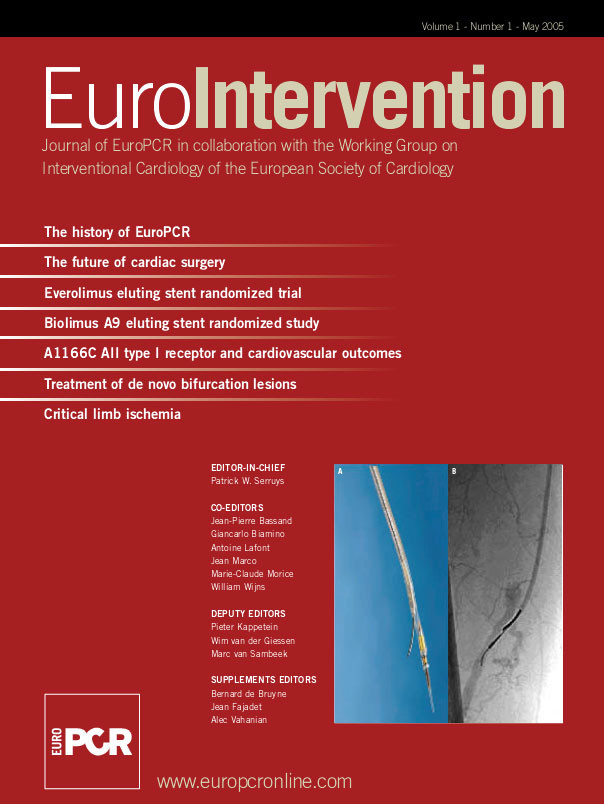The advent of drug-eluting stents has revolutionized the treatment of coronary artery disease. Randomized controlled trials of sirolimus-eluting or paclitaxel-eluting stents had demonstrated that they significantly reduce neointimal hyperplasia formation when compared to bare metal stents, as evidenced by reduced angiographic late loss and binary restenosis rate1-8. This resulted in an improved clinical outcome with lower target vessel or lesion revascularization rates.
In order to develop a new competitive or even more efficient drug-eluting stent system, new anti-proliferative and anti-inflammatory agents are currently clinically tested. Among this large group of potent agents, sirolimus derivatives such as everolimus, ABT 578 or biolimus A9 are the most evaluated and successful drugs in clinical trials so far. The characteristics of these drugs are partially similar to sirolimus which makes them somewhat predictable, but leave enough room for potentially superior elution characteristics, improved tissue distribution patterns, or restenosis inhibition properties. By making various modifications to the “rapamycin ring structure” of sirolimus, i.e. by adding or removing atoms or chemical groups, it is possible to create derivatives with increased lipophilicity, varying potency, less immunosuppression, and greater or lesser growth inhibition or toxicity to rapidly proliferating cells.
For instance, compared to sirolimus, everolimus, ABT 578 and biolimus A9 have a more rapid local tissue absorption and a longer cellular residence time and activity. It is interesting to note that all three of these new sirolimus derivatives involve position 40-O modifications which increase the lipophilicity but not the potency of the agent.
Randomized clinical studies including more than 1400 patients have been performed so far to evaluate the effects of stents eluting sirolimus analogues. All of them demonstrated safety outcomes similar to conventional bare metal stents. With regard to the efficacy outcome, the data were more heterogeneous; particularly when looking at the ‘hard’ angiographic efficacy measure ‘late lumen loss’ as in indicator for power of suppression of neointimal proliferation rather than the more clinically relevant parameter ‘re-intervention’. Both the FUTURE I and II trials, which evaluated an everolimus eluting stent with a bioabsorbable polymer coating9-11, and the SPIRIT FIRST study, which aimed at safety and efficacy of an everolimus eluting stent with a durable polymer12, demonstrated target lesion re-intervention rates ranging between 3.8% and 4.8% at 6 month follow-up and an in-stent late loss of 0.10-0.12mm, which is comparable to the results observed in SIRIUS with the sirolimus eluting Cypher stent.
Stent-based elution of biolimus A9, the newest member of the ‘limus’ family, revealed almost similar efficacy results in STEALTH I to everolimus and sirolimus eluting stents (TLR 1.3%; in-stent late loss 0.26mm)(Grube et al., TCT 2004).
Comparable clinical efficacy outcomes were seen in the ENDEAVOR trials evaluating an ABT-578 eluting stent design, although there were indicators for differences in the potency of neointimal hyperplasia suppression.
ENDEAVOR I was a 100-patient, prospective, multicenter study with a low target vessel failure rate of 2% at 4 and 12 months follow-up, but detected an increase of in-stent late loss between these follow-ups from 0.33mm to 0.58mm (Meredith et al., EuroPCR 2004), which is somewhat higher than the 6 or 9 months values observed in SIRIUS, FUTURE or STEALTH. The subsequent pivotal ENDEAVOR II study with 1,197 patients resulted in a significant 47% reduction of target vessel failure in the Endeavor arm (8.1%) compared to 15.4% in the control, but confirmed a tendency for a higher late loss level with an in-stent result of 0.63mm (Wijns et al., ACC 2005). As evidenced by the clinical efficacy endpoints, these late loss values did not translate into a higher rate for target lesion re-interventions, which makes the result of a late loss ranging between 0.55-0.65 mm a clinically irrelevant finding for these specific patient subsets. However, further studies on more complex patient subgroups are necessary. We have learned from CYPHER and TAXUS trials in more complex scenarios, that the late loss is increasingly important when treating lesions with high risk for restenosis, and a higher late loss may then affect the clinical outcome.
Given the data available so far, it is reasonable to conclude, that all of the members of the ‘limus’ family currently in clinical testings are promising candidates for drug eluting stent concepts. However, additional stent design characteristics such as appropriate stent platforms as well as biocompatible durable or bioerodable coatings will play an equally important role in creating the ideal drug-eluting stent platform. It’s the interaction of firstly the eluted drug and then the remaining stent platform with the target vessel biology that determines the outcome of the drug eluting stent over time. We still have to learn more about these late effects that could occur once the drug is completely gone. However, an effective anti-proliferative drug is certainly prerequisite. The “dual action” of sirolimus derivatives, i.e. the ability to provide immunosuppression at the injury site as well as antiproliferative action on smooth muscle cells in the vessel wall, seems to be presently unmatched by any other drug types used on stents. The ‘limus’ family of drugs had clearly demonstrated their potency to reduce neointimal hyperplasia when appropriately dosed and released from a stent, and will likely play a central role in future generations of drug-eluting stent designs.

